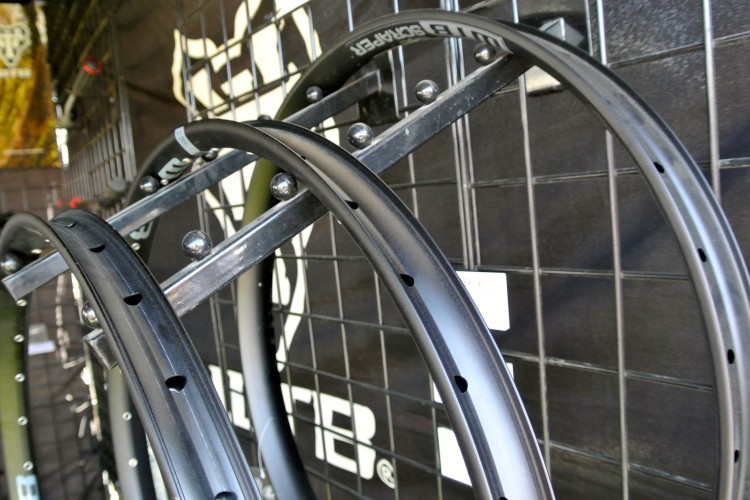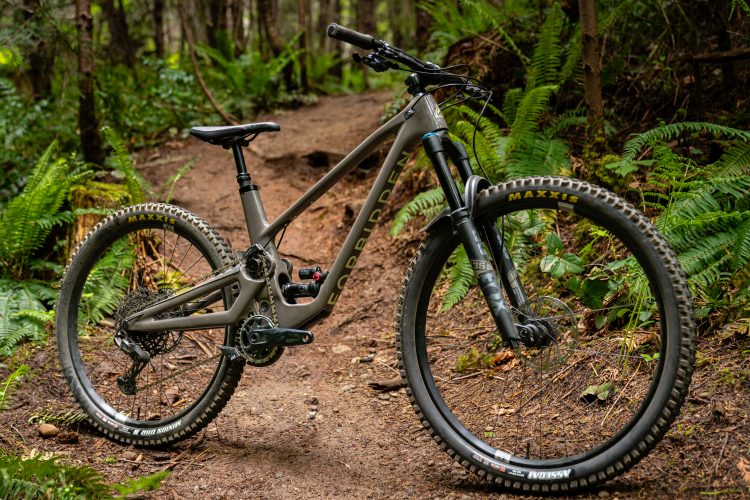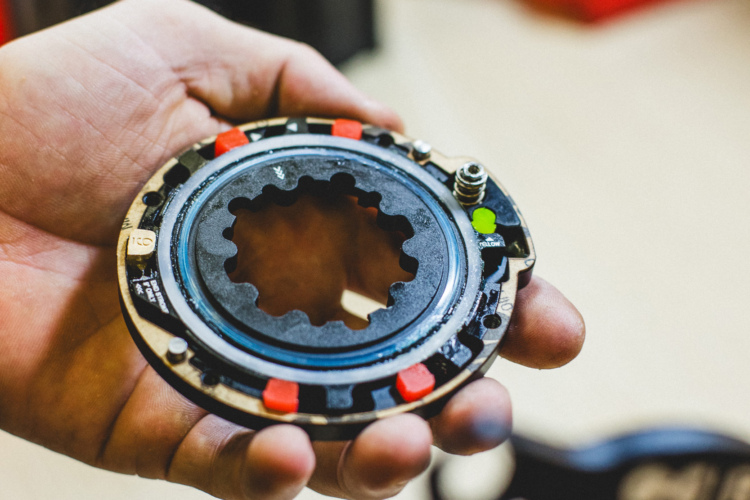
For those of us who headbanged through adolescence in the 1980s, the word mullet might evoke images of a haircut we’d rather forget ever having. Elementary school class photos are all the reminder I need of mine, and thankfully those line a dusty drawer at my parents’ house up in “almost Canada” Idaho. The hairdo was a compromise between the long metal-locks I wanted and the boring crop my parents thought was best. It wasn’t the most positive introduction to the concept of compromises.
Are the mullet bikes of today a similarly shabby compromise, or are they the real-deal best way to ride a modern mountain bike? Mixed-wheel or mullet bikes promise all of the front tire traction and plow-like rollover capabilities of a 29er, paired with the faster spin-up and maneuverability of a 27.5″ rear wheel. So is there scientific testing to back any of that up, or is it simply another way for bike brands to add a notch on the N+1 list?
Though a few bike brands jumped wholeheartedly into the mullet madness, most of them have only tested the waters at this point. Maybe their pro riders are running a mixed-wheel setup for certain events, or their DH frame geo can be adjusted to work with 29″, 27.5″, or mixed wheelset. But unlike the broader trend toward 29″ wheels over the past few years, the mullet-mix has yet to fully catch fire.

We contacted a number of mountain bike frame companies over the last few weeks to ask how they are going about testing mixed-wheel options, and what the future looks like for the quaffy mashup. Following the longstanding trend of mixed wheel sizes in motocross, Foes Racing was one of the first companies to test and design their frames around the 27.5″/29″ configuration in 2014. Beginning in 2015 two frames out of their six-model lineup were built on the mullet platform, and both are available still today.
Denver-based Alchemy Cycles leaped into action with a dedicated mullet whip in 2019, and their motivation was entirely race-focused. The brand’s main EWS athlete at the time, Cody Kelley, was frustrated with the big wheels on tighter and more technical European tracks, but he wanted to maintain the 29″ plowability for faster segments. Alchemy Cycles mountain bike product manager, Joel Smith, said that Kelly “was experiencing issues with turning quickly in those awkward situations, with a full 29er. So we started looking into it. It was pretty easy to move forward on something because we have a full CNC shop and manufacturing facility in Denver. We went ahead and redesigned the link, put a wheel in it, and started testing to see if it was going to solve the specific issue — which was, when it’s awkward, turning faster and quicker acceleration.” With a little refinement, they were able to dial the bike in and offer what Kelly recognized as “faster acceleration while driving off the rear wheel out of turns.”
As soon as the bike was ready, Kelley started racing the Nine7Five frame whenever the race course called for its expertise. Apart from one professional athlete’s needs, Smith mentioned that the mixed wheel setup is particularly relevant for shorter folks who want the benefit of a 29er without the overall length and girth of traditional wagon-wheeled whips.
Both Alchemy’s short- and long-travel 29″ full suspension bikes can be mulleted by swapping the main suspension link and changing the shock, so for those who have an Arktos in the quiver and want to test it out, give them a call. Smith mentioned that customers are being fairly cautious when it comes to mullet bikes. At demo days, those are the bikes everyone wants to try, but the sales numbers are nowhere near reflecting that enthusiasm.

Joe McEwan from Starling Cycles in the UK offered up a clean list of the benefits he feels mullet bikes present.
“Gyroscopic stability on the front wheel where tracking and grip are most important, less stability on the rear which helps with maneuverability a little, it’s easier to run more travel on rear end, easier to have shorter chainstays on the rear triangle which also benefits maneuverability, [and lastly the mixed-wheels offer] more wheel-to-arse clearance for shorter riders.”
McEwan dug further into the benefits of 29″ vs 27.5″ wheels during our discussion, sharing a decidedly more scientific viewpoint than many of the other frame designers I spoke with. My burning question was, how does the smaller 27.5″ rear wheel, with its central contact patch in the same place as a 29″ wheel with the same chainstay length affect how the bike handles? McEwan was first up with a clear answer.
To me, the biggest driver for 29ers is the additional gyroscopic stability of the bigger wheels. Gyroscopic stability affects how hard it is to move the wheel out-of-plane, and consequently how stable it is when moved. The gyroscopic stability increases according to a diameter squared term, so the bigger wheels have much more stability.
It takes much more rider impact to lean a 29er over, but once there it is much more stable. This gives great stability in corners, grip on off-camber [terrain], and stability in the rough as the wheel isn’t kicked off line (often read as better roll over).
Anyway, although gyroscopic stability is often a benefit, it reduces the maneuverability of the bike. For example hopping and popping in and out of ruts is harder. Take tailwhips on a BMX for example!
Finally, the former aerospace engineer turned frame builder pointed out that not all mullets are cut equally.
“[The] only other point to mention is that a bodged mullet, i.e. just shoving a 27.5″ wheel in a 29″ bike, is not a mullet. The BB drops too much, and head angle slackens too much. Bikes need to be designed to have the right geometry with the wheel size they use. Like my bikes, for example, there is no compromise in geometry. The amount of bike magazine/media outlets that have done this [DIY mullet] and then compared the results is amazing.”
Instead of throwing together a liger in the basement, we hope to have a Startling Twist in for test this summer and will report on how the steel squishy mixer feels.
Team Liv Racing athlete Rae Morrison competed in the final three rounds of the 2019 Enduro World Series aboard her Liv Hail Advance mullet, and she has some intriguing insight to share.
I’ve been on the mixed wheel size since Whistler 2019. I was going between a 170 and 160mm 27.5 fork and wheel combo for most racing but just found I was being pitched toward the front of the bike in too many situations and it was causing me to change my usual aggressive position to a more timid approach.
We experimented with a larger headset cup stack and reach adjustment on a medium frame first. Then went to a lower stack cup on a large frame to get the reach and stack preference numbers tested. This means we could see what I would need those geo numbers to look like before going to the 29er wheel
When we first made the swap we put a 29er wheel into the 27.5 DVO diamond fork to keep the axle to crown the same, and left it at 170mm for testing in Whistler. This enables us to get an idea of what the extra static and dynamic ride height of the 29er front wheel would have on the bike. Straight away it was really good. We then settled on going to a 160mm 29er DVO Onxy fork in a shorter offset to help keep the steering nimble and to keep the BB height and stack height as close to what I had preferred in testing. Going into Whistler EWS I was stoked on how the bike was working for me and I ended up with my best result of the year taking 6th place.
I love the way the smaller rear wheel moves in and out of turns, it accelerates quickly, it’s stiffer and it’s lower unsprung weight is always a benefit. Having the extra front tyre contact and grip, roll over ability and not getting pitched forward in holes means that the mullet is hands down the best of both worlds. It lets me ride the way I’m most confident and comfortable without any downsides.

Of course, we can’t blather on about mullet bikes without mentioning the success of GT Bicycles riders Noga Korem and Martin Maes. Maes’ palmares speak volumes of his talent. He stepped off his GT Force mullet bike onto the top step at round three of the 2019 EWS in Funchal Madeira, placed fourth at the dusty Northstar, California event, and made the top step again for the final round in Zermatt, Switzerland.
Korem earned a second place overall in the 2019 EWS season, finishing in the top five after every round of the series last year, save the final race in Zermatt where she broke her derailleur and had to run parts of the track. With only three stage wins to her name throughout the eight race series, Korem’s winning strategy appears to be one of consistency and focus. The Force Carbon mullet has clearly suited the young Israeli rider quite well.
We had a chance to chat with the dirt frame designers form GT, and like the folks at Alchemy, their mullet moves are entirely inspired by rider desire and feedback.
“Our Force [27.5″] is also compatible with a 29er front wheel as long as you’re utilizing the same geometry, in terms of transferring your 27.5″ fork to a 29er fork. So, for example, a 170mm 27.5-inch fork is roughly the same axle-to-crown [measurement] as a 150mm 29er fork. As long as you keep that rough geo it’s good. That’s something we do advertise as an option, in terms of the 27.5-inch Force Carbon model.”
The GT Fury downhill bikes are equally mullet compatible in the same way. As long as the originally intended axle-to-crown fork measurement is maintained, the geo is essentially the same, and you are good to mullet.
As far as the inspiration to test for GT, it’s largely based on an experiment.
“Our factory racing team are our pilots of innovation. When we’re developing stuff we’re going to work closely with them. When they approached us with the mixed wheel question we said go for it. Try it out and let us know how it works.”

We also got in touch with Damien Nosella from Production Privee to get his take on mixing wheel sizes.
“Mixed wheels and 29ers are usually faster and easier on a full day of enduro. Enduro is about performing during one or two days on the bike, and for us at Production Privee, we believe that a bike that is easier to ride will make the average amateur rider/racer perform better. It also depends on a rider’s ability, feeling, and size. For my size,1.96m (6’4″), if I look at the overall picture, I prefer 29/29, for example.”
So why doesn’t Production Privee make a steel full suspension mullet bike? Nosella says, “I personally adopted that setup until I got the first proto of the 29er. At Production Privee we look for riding characteristics and overall dynamics, especially on the downhill side: rolling capability, the ease to adapt to the bike, how it interacts with terrain, obstacles on the straights, obstacles during curves, how the handling feels. This all is compared on timed runs. We ditched the mullet bike because it doesn’t make sense commercially for our brand size, so far. It also would mean having a dedicated frame to have the proper geo to benefit the max from the mullet setup.”
Summing it up
So, how do we get a mullet bike? Either buy one specifically designed around the mixed wheel size, or convert a 27.5″ bike by using a 29″ fork with the same axle-to-crown measurement. Of course, that method is going to work best with 27.5″ bikes that have at least 2-3cm more travel up front than out back. That way when you cut travel to compensate for the longer 29″ lowers, the bike will have equal travel front and rear, or slightly more up front.
Why mullet bikes? I think this query is best answered in Joe McEwan’s quote above. Riders can maintain the inherent stability of a 29er in corners and over rough terrain while experiencing improved maneuverability out back due to the smaller wheel’s tendency to both lean in and spin up faster.
Have you ridden a mullet bike? Please share your experience below.





















7 Comments
Apr 9, 2020
Apr 3, 2020
Apr 4, 2020
Today I "Stuck a 27.5 rear wheel" on my 29er Stumpy. Yes the BB came down a little but not as much as you would expect. To counter this, I went with a 165 crank length over the stock 170 and added a bushing/spacer under the head tube to extend the fork. All is done, the pedal is no lower to the floor than it was before the change. Strikes are not too much an issue so long as you know how to pedal.
I would love nothing more than to try an engineered mixer but it's not as popular as it should be in my opinion.
I'll never ride a non mixer in the trail again.
Mar 31, 2020
Apr 3, 2020
Apr 1, 2020
Apr 2, 2020